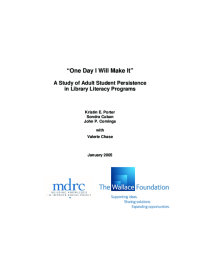"One Day I Will Make It"
A Study of Adult Student Persistence in Library Literacy Programs
Although research indicates that adults with low literacy skills need 100 to 150 hours of instruction to advance one grade level, adults in literacy programs participate in instruction for an average of only 70 hours per year. The Wallace Foundation launched the Literacy in Libraries Across America (LILAA) initiative in 1996 to help library-based literacy programs nationwide increase the persistence of their adult learners, and it contracted with MDRC and the National Center for the Study of Adult Learning and Literacy (NCSALL) at Harvard University in 1999 to study the initiative. The participating libraries were granted resources to develop and implement persistence strategies that included improved instruction, more varied and more extensive social supports, and technology upgrades. This is the fourth and final report from the persistence study, which examined the implementation and effects of these strategies in nine library literacy programs over four years and whether student participation changed over time.
Changes in Student Participation and Achievement
- Throughout the study period, students’ average participation in program activities fell well short of the level required to improve their literacy skills. For all demographic groups in the study, the duration and intensity of participation did not change substantially over time.
- Standardized tests showed modest increases in achievement. No relationship was found between students’ number of hours of participation and their achievement gains.
Challenges in Implementation
- The strategies closest to libraries’ core mission of improving literacy — such as expanded computer-assisted instruction and improved tutor training — were implemented with relatively little difficulty. Rather than breaking with past practice, these changes were predominantly incremental.
- Most of the programs were reluctant to develop a social service capacity. In the few exceptions, social services were restricted to on-site child care or transportation vouchers, were implemented slowly, and did not fully address students’ needs.
- The emphasis on programmatic over social service strategies limited programs’ potential to improve persistence, because many students had barriers to participation, such as unstable work hours, child care or transportation needs, or health problems.
Pathways to Persistence
- Different “pathways to persistence” emerged. Some students stopped participating after the first few months. Others participated only intermittently because of barriers to participation. A minority of students were long-term participants.
- Although it is impossible to predict which pathway an individual student will follow, library literacy programs might increase their influence on persistence by acknowledging and accommodating multiple pathways, in these ways:
- Offer realistic social supports — especially for students not on the long-term pathway — such as on-site child care timed to coincide with evening instruction.
- Develop a system for referring students to social service and other education providers that are better equipped than libraries to help students cope with barriers to persistence.
- Adapt and add programmatic features, such as off-site instruction and drop-in classes, to make literacy services accessible to students on all pathways, and develop learning plans, to enable students to make progress even when they cannot attend program activities.






